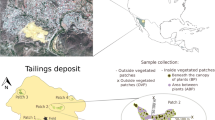Abstract
Approximately 2000 derelict (abandoned) mine sites exist in New South Wales (Australia) from mining and prospecting activities that date back to the mid 1800s. The major objective of this study was to identify a range of native species suitable for use in the rehabilitation of three major derelict mine sites identified in New South Wales namely Howell (Zn, Cu, Ag, Pb), Mole River (As) and Woodsreef (asbestos) through glasshouse pot trials. Waste rock material from each of the three sites was subject to four treatments namely a control, tailings, mulch and tailings/mulch treatment, with 13 species (trees, shrubs and grasses) and four replicates (total of 624 pots).The Mole River and Howell waste rock and tailings provided a similar chemical environment for plants at the start of the experiment (deficient nitrate-N, low pH, high EC) compared to the Woodsreef substrates (deficient nitrate-N, high pH, low available P, high Mg). At the completion of the experiment, Mole River generally had the least favourable chemical environment for plants (highest Zn, Fe, Mn), Howell was intermediate and Woodsreef the best (highest Ca, Mg, pH and lowest metals). Two grass species, Cynodon dactylon and Dicanthium sericeum, exhibited the highest emergence rate (40%), although the emergence of 11 out of 13 species was greater than 12%. In general, mean annual height growth and cover of all species was higher in the mulch and tailings/mulch treatments than the control and tailings treatments. Cynodon dactylon recorded the highest mean annual height increase across the species (66 cm yr-1), with the tree species,Eucalyptus camaldulensis and Casuarina cunninghamiana, also exhibiting relatively good growth. Mean percentage mortality of all species was generally lowest in the Woodsreef substrate, intermediate in the Howell and highest in the Mole River materials. Mulch treated pots recorded the lowest mortality at all sites. With the exception of Dicanthium sericeum, Aristida ramosa and Casuarina cunninghamiana, mean biomass estimates for all species were significantly higher in the mulch and tailings/mulch treatments compared to the control and tailings treatments. Cynodon dactylon yielded more biomass (mean = 5 t ha-1) in comparison to the other species. The direct implications of these results to the rehabilitation of derelict mines in the New England Tablelands are also discussed.
Similar content being viewed by others
References
Australian and New Zealand Environment and Conservation Council: 1992, Australian and New Zealand Guidelines for the Assessment and Management of Contaminated Sites, ANZECC, Sydney, Australia.
Ashley, P. M. and Lottermoser, B.: 1998, Environmental Geochemistry of the Mole River Arsenic Mine, Northern New South Wales, Technical Report to the NSW Department of Land and Water Conservation, University of New England, Armidale, NSW, Australia.
Bell, D. T., Plummer, J. A. and Taylor, S. K.: 1993, 'Seed germination ecology in south-western-western Australia,' Botanical Review 59, 24–73.
Blair, M.C.: 1996, 'Woodsreef Asbestos Mine, Barraba – A Preliminary Risk Assessment', Bachelor of Natural Resources Project Report, University of New England, Armidale, NSW, Australia.
Boutkaska, B.: 1998, 'An Investigation into Selection of Species for Rehabilitating Howell Derelict Mine Site on the New England Tablelands', Bachelor of Natural Resources Project Report, University of New England, Armidale, NSW, Australia.
Brooks, K. A. and McIlveen, G. R.: 1988, 'The Impact of a Derelict Base Metal Mine on the Aquatic Environment', The Third International Mine Water Congress, Melbourne, Australia.
Burns, M. W.: 1988, 'Physical and Chemical Factors Affecting Native Tree Establishment on Reformed Open-cut Coal Mine Sites within the Hunter Valley', Master of Resource Science Thesis, University of New England, Armidale, New South Wales.
Charman, P. E. V. and Roper, M. M.: 1991, 'Soil Organic Matter', in Soils: Their Properties and Management – A Soil Conservation Handbook for NSW, Sydney University Press, Sydney, Australia.
Cumming, R. W. and Elliott, G. L.: 1991, 'Soil Chemical Properties', in P. Charman and B. Murphy (eds), Soils: Their Properties and Management – A Soil Conservation Handbook for NSW, Sydney University Press, Sydney, Australia.
Department of Mineral Resources: 1996, 'Derelict mined land rehabilitation program', Minfo 51, 13–14.
Department of Mineral Resources: 1998, 'Woodsreef: a study of risk', Minfo 59, 14–16.
Elliott, G. L., Hannan, J. C. and Cornally, M. J.: 1980, 'Revegetation of open-cut mine overburden at Foybrook, NSW', J. Soil Conser. Serv. NSW 36, 24–240.
Harden, G. J.: 1993, Flora of New South Wales, University of New South Wales Press, Sydney, Australia.
Lyle Jr., E. S.: 1987, Surface Mine Reclamation Manual, Elsevier, New York, U.S.A.
Munshower, F. F.: 1994, Practical Handbook of Disturbed Land Revegetation, Lewis Publishers, London, U.K.
Millar, P.: 1996, 'Reclamation Options for the Mole River Arsenic Mine, Tenterfield, NSW', Master of Engineering Project Report, University of New England, Armidale, NSW, Australia.
New South Wales Environment Protection Authority: 1996, Derelict Mine Study 1995 – Northern Tableleands Region, Commonwealth of Australia, Canberra, Australia.
New South Wales Environment Protection Agency: 1997, Best Practice Environmental Management in Mining – Rehabilitation and Revegetation, Commonwealth of Australia, Canberra, Australia.
Rayment, G. E. and Higginson, F. R.: 1992, Australian Laboratory Handbook of Soil and Water Chemical Methods, Inkata Press, Melbourne, Australia.
Richards, C.: 1998, 'Woodsreef: Development of a Rehabilitation Strategy', Bachelor of Natural Resources Project Report, University of New England, Armidale, NSW, Australia.
Singer, M. J. and Munns, D. N.: 1996, Soils: An Introduction, 3rd ed., Prentice Hall, New York, U.S.A.
State Pollution Control Commission: 1978, Environmental Objectives and Priorities for Derelict Mined Land Rehabilitation Programs, Environmental Guide EGM-1, NSW Government, Sydney, Australia.
State Pollution Control Commission: n.d., 'Survey of Derelict Mined Land Emmaville NSW', Technical Report prepared by Gutteridge Haskins and Davey, Sydney, Australia.
Wadds, S. L.: 1987, 'A Geochemical and Environmental Investigation of the Conrad Pb-Ag Mine, Tingha, NSW', Bachelor of Science Honours Thesis, University of New England, Armidale, NSW, Australia.
Author information
Authors and Affiliations
Corresponding author
Rights and permissions
About this article
Cite this article
Grant, C.D., Campbell, C.J. & Charnock, N.R. Selection of Species Suitable for Derelict Mine Site Rehabilitation in New South Wales, Australia. Water, Air, & Soil Pollution 139, 215–235 (2002). https://doi.org/10.1023/A:1015860025136
Issue Date:
DOI: https://doi.org/10.1023/A:1015860025136




